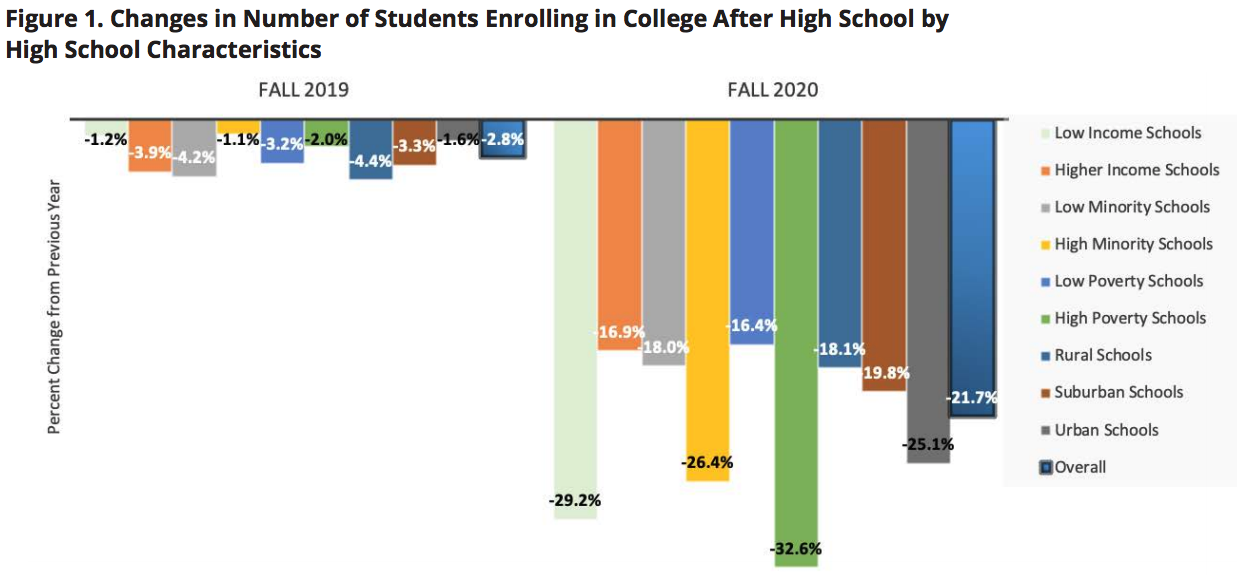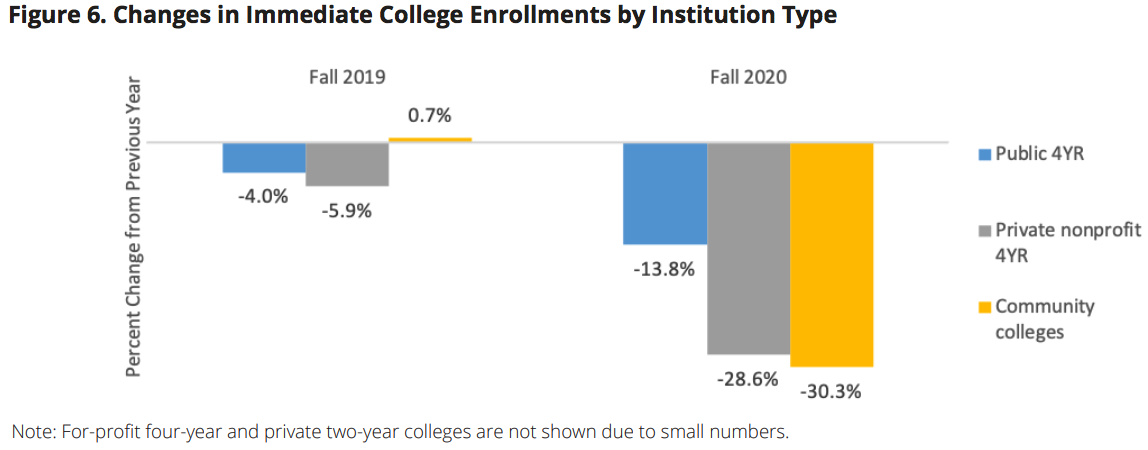How is higher education enrollment changing this year?
I’ve been tracking enrollment trends for years. In 2020 things have become more strange and intense, given the combination of pandemic and bad recession. So far the best data we have shows that the total number of students taking classes at American colleges and universities has declined during the fall semester by about 3.3%. This drop is sharper than the steady decline we’ve seen for nearly a decade.
A new report today sheds some light on this topic.
The number of student who graduated from high school in 2020 and proceeded directly to higher ed fell by 21.7%.
I’d like to share highlights that struck me as important. Let’s dive in.
One quick caveat: not all college and university students are recent high school grads, despite the popularity of this image. A good chunk are adults. In today’s post we’re just focusing on the 18-year-old segment.
![]() The report comes from the National Student Clearinghouse Research Center, which has been doing great work on enrollment data.
The report comes from the National Student Clearinghouse Research Center, which has been doing great work on enrollment data.
A key finding from this latest publication is that while COVID doesn’t seem to have slowed down high school graduation rates, it seems to have cut back that population’s college enrollment by more than one-fifth: “21.7 percent, nearly eight times the pre-pandemic loss rate (-2.
8%).”
Put another way,
The immediate college enrollment rate decreased to 27.7 percent from 35.3 percent last fall, a decline ten times steeper than last fall’s drop (from 35.9% in 2018 to 35.3% in 2019).
That figure doesn’t cover variations by race, geography, or class, which the report does address. High schools with a majority of students who are poor, or underrepresented minorities, or from cities sent far few graduates straight to college than the rest:
What kinds of higher education institution are these students attending, or not? It looks like recent high school grads are avoiding community colleges most of all:
Summing up, Inside Higher Ed quotes the Clearinghouse’s director, Doug Shapiro:
[T]he pandemic impacted high school graduates in their immediate college enrollment, and those from high poverty, low income, and urban high schools have been hit the hardest. The enrollment gaps appear to be widening because of COVID-19.
University Business describes this development as “an alarming free-fall in the postsecondary enrollment rate.”
Why does this matter?
First, if higher ed is currently experiencing an increased focus on equity gaps, it looks like that problem just got worse, at least when it comes to recent high school graduates.
Second, unless these numbers completely reverse themselves in fall 2021, higher ed will have to deal with this hole for the next few years.
Third, this could give some institutions the incentive to work more closely with high schools in order to improve that pipeline. The opposite is also possible, in that campuses could decide to double down on adult learners.







Wow….this is substantial. I appreciate your point that not all of first-time, first-year students have come directly from high school — but still. Wow….
Which raises the question, are “immediate enrollers” from high school dropping faster than other age cohorts?
The local newspaper (you would not BELIEVE how much it costs now!) is running stories about the school district scrapping it’s entire online program (the state version remains operating), about teachers retiring and burning out, about problems finding substitutes (bus drivers in the class room — no, I’m making that up. I hope.), and D and F grades at more than 40% of the “honors” classes (because parents are burned-out from doing their kids’ homework and other school work?:-)
I’m sure the next round of stories will be about budget cuts, since Florida must balance its budget. But don’t hold your breathe — stories about budget cuts are like blood in the water, and everyone that knows this is keeping their mouth shut.
The secondary education foundation of the higher ed pyramid is crumbling, and the primary foundation for secondary is in even worse shape. Waivers all over the place for EOC testing, etc.
It looks like “back to the future,” to the 1920s when only “rich kids went to college”.
“Savage inequalities” are getting more savage.
Yeah. Here’s the HS report that Bryan linked to
https://nscresearchcenter.org/wp-content/uploads/2020_HSBenchmarksReport.pdf
Higher ed in the US has almost always reinforced and reflected class inequality, with federal intervention at times making things better. Elite schools were built from the oppression of native peoples and the enslavement of captured souls from Africa (see Wilder’s Ebony and Ivy). And the last 50 years have been a regression from advances in the 1940s, 50s, and 60s as for-profit greed has taken over just about everything.
Today, higher ed is a risky choice for working families. I hope that at some point you will interview Gary Roth, author of The Educated Underclass. You ought to talk to Richard Wolff about all of this.
https://collegemeltdown.blogspot.com/2020/10/the-college-dream-is-over-gary-roth.html
https://en.wikipedia.org/wiki/For-profit_higher_education_in_the_United_States
Check out the books at the end of this article.
https://collegemeltdown.blogspot.com/2019/07/college-meltdown-resources.html
From the futurist’s POV, this is a fat tail event that wags the dog. Futurists cringe when unforeseen disasters hit, like Taleb says, because they can redefine the social and cultural system. Come to think of it, this point is even more pronounced in Per Bak, the sand-pile man. https://en.wikipedia.org/wiki/Per_Bak
Depends on the futurists. Some of us try very hard to anticipate disasters, and even use Taleb’s work.